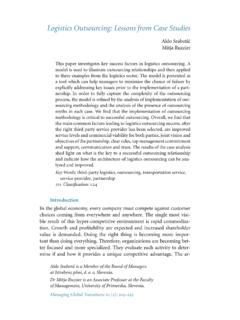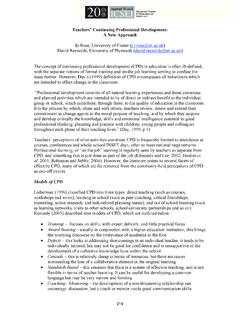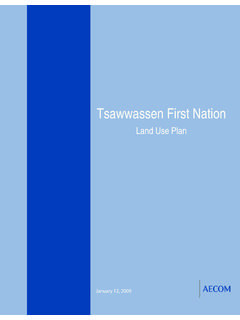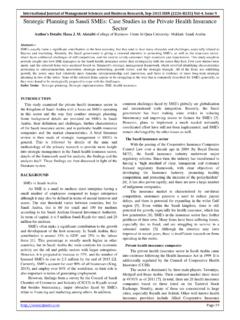Transcription of A Strategic Household Purchase: Consumer House …
1 A Strategic Household purchase : Consumer House Buying BehaviorMateja Kos Kokli cIrena VidaThe aim of this study is to examine Consumer House -buying behaviorfrom the consumers perspective. In view of the existing literature ex-ploring Consumer decision making, the purpose of this research wasthreefold: (a) to propose a conceptual model of Consumer decisionmaking within the frame of Consumer behavior; (b) to gain knowl-edge of factors impacting this process from the empirical standpointwith the focus on prefabricated House purchases; and (c) to offer im-plications for beneficial purchases of prefabricated houses. The resultsof our in-depth interviews with recent owners and potential buyers ofa custom-made prefabricated House suggest that cognitive and ratio-nal factors do not offer sufficient explanation of Consumer behavior inthe case of a high-involvement product such as a House .
2 In addition tothe idiosyncratic characteristics of the customer, his/her personal situ-ation and environmental factors, the role of feelings, experience, sub-conscious factors, needs and goals should to be taken into account tobetter understand this kind of decision y Words: Consumer decision-making, Strategic purchase ,prefabricated House , qualitative researchjelClassification:m30,m31 IntroductionThe field of Consumer research is mostly focused on two major ques-tions: how consumers go about making decisions (descriptive theories),and how decisions should be made (normative theories) (Edwards andFasolo2001). Research directives, aimed at researching how consumersshould decide, have been emerging lately. Several critiques have ap-peared against the existing literature which focuses almost exclusively onthe marketing perspective and neglects consumers and their difficultiesin decision making (Bazerman2001; Gronhaug, Kleppe, and HaukedalMateja Kos Kokli c is an Assistant at the Faculty of Economics,University of Ljubljana, Vida is a Professor at the Faculty of Economics,University of Ljubljana, Global Transitions7(1):75 9676 Mateja Kos Kokli candIrenaVida1987).
3 Brief and Bazerman (2003,187) developed the idea that creatingtruevaluefortheconsumerand,thus, addingvaluetosocietyisoneofthe most obvious ways business organizations make the world a betterplace . This notion of a Consumer -focused approach is also supported byBargh (2002), who believes Consumer research should balance studiesof how to influence consumers with studies of how consumers coulddefend themselves against and control such of the most influential areas within Consumer behavior is con-sumer decision making (Bargh2002; ; Bettman,Luce, and Payne1998). At the conceptual level, various Consumer deci-sion-making models have been proposed in the literature in recentdecades. However, many researchers believe that a specific, situation-and product-oriented model is needed in studying purchasing (Eras-musm, Boshoff, and Rousseau2001). Apart from this, investigating deci-sions, that can change lives of consumers, such as car or House purchase ,can make an essential contribution to Consumer behavior knowledge(Wells1993).
4 According to Erasmus, Boshoff, and Rousseau (2001), anexploratory approach with the intention to unfold the truth may pro-vide opportunities for an understanding of the complexity of specificdecision-making circumstances, such as first-time House view of the existing literature exploring Consumer decision mak-ing when purchasing high-involvement and emotionally charged prod-ucts, the purpose of this research was threefold: (a) to develop a con-ceptual model of decision making for a prefabricated House purchase ;(b) to gain knowledge of factors impacting this process from the em-pirical standpoint; and (c) to offer implications for beneficial strategichousehold purchases. Strategic decision making refers to the process ofdecision making with long-term commitments of resources and affect-ing the budget available for other goods and services (Gronhaug, Kleppe,and Haukedal1987,242).
5 Based on the existing literature, we assume thatthis process involves a certain amount of perceived risk, especially since itrepresents large financial obligations (Gibler and Nelson2003; Mitchell1999; Gronhaug, Kleppe, and Haukedal1987; Beatty and Smith1987).Ourgoalisalsotooffer implications for consumers, real estate marketersand Consumer researchers. The specific product selected in this study wasa prefabricated House . The House is the most important durable good inthe Household and requires high involvement as well as complex deci-sion making. Some similarities can be drawn with other durable prod-ucts, particularly cars. Hence, the empirical literature in this area and theManaging Global TransitionsA Strategic Household Purchase77real estate literature serve as a basis for conceptual and empirical work inthis BackgroundConsumer behavior has been an important research topic for decades.
6 Areview of existing theoretical efforts indicates a clear shift from rationalto psychological and social decision factors. However, even the recentmodels have not managed to embrace all the knowledge in the field ofconsumer behavior: subconscious processes, the role of needs, goals andemotions (Bargh2002). Apart from leaving out these important find-ings the existing literature also lacks studies of decisions that consumersare most concerned about, termed big or Strategic decisions (Bazer-man2001,500; Gronhaug, Kleppe, and Haukedal1987,242). Specifically,Bazerman (2001) urges researchers to further explore the most impor-tant and challenging Consumer decisions, which include House and carpurchases, dealing with a building contractor mentioned in the introduction, Strategic decision making refersto the process of decision making when buying strategically importantgoods.
7 The following characteristics define the Strategic importance ofa purchase : high involvement in the process; long-term commitmentof resources; truncated budget available for other goods and purchases imply several important categories of decisions, in-cluding: decisions with regard to allocation of the Household budget, namely,how the Household s economic resources are influenced, e. g. fortravelling, visits to restaurants etc.; categorization of alternatives means choosing either from variousproduct groups (e. g. apartments or houses) or defining a more nar-row product category (e. g. houses of a given size); decision making within the defined product category takes placeonce the product group is purchase of a House may be considered as a good example ofsuch a purchase decision. Strategic decisions are being made in a rangeof fields, including when consumers decide about health issues (Henry2001) or financial investments (Henry2005).
8 Considering the focus of this study on Consumer behavior with re-spect to a very specific product, i. e., a prefabricated House , empiricalresearch in the area of durable goods needs to be examined to supportVo l u m e7 Number1 Spring200978 Mateja Kos Kokli candIrenaVidaexisting theoretical knowledge. Empirical research conducted in the fieldof durable goods purchase behavior can be useful for at least two rea-sons: (a) the House is the most important durable good in the Household (Hempel and Punj1999); and (b) many studies of Consumer decisionmaking for a car or Household appliances indicate that there are sim-ilarities among the buying processes related to different durable goods(Punj1987). The majority of literature researching individual and orga-nizational customers is dealing with buying processes of durables (e. ; Cripps and Meyer1994; Grewal, Mehta and Kardes2004;Hauser and Urban1986;McQuinston1989; Punj and Brookes2002).
9 Compared to buying convenience products, consumers perceive thesekinds of large ticket purchases as riskier, sometimes even traumatic (Bauer1960;Chaudhuri2001; Mitchell1999). Outcomes of such pur-chases are unknown in advance and some of them are likely to be un-pleasant. A common attribute of durables is that the buying decision iscomplex, especially when the price is perceived as strongest parallel can be made with a car purchase , particularly asthe car is the second most important durable acquisition in the House -hold. Buying a House or a car highly involves the Consumer , as thisdecision binds their economic resources in the long run (Arndt1976;Gronhaug, Kleppe, and Haukedal1987; Grewal, Mehta and Kardes2004;Rosenthal1997). Both product categories offer a rich variety of price andquality, are complex and relatively well known to consumers (Brucks,Zeinthaml, and Naylor2000; Bayus and Carlstrom1990).
10 Similarly, thebuying decision for real estate as a subgroup of durables is also com-plex and demands high involvement (Gibler and Nelson2003). In mostcases, consumers consider several possibilities, compare them and ulti-mately make a selection (Bayus and Carlstrom1990). In comparison tofrequently purchased items, learning on a basis of trial-error is uncom-mon when buying expensive, complex products (Bazerman2001).Prior to model building efforts, however, characteristics of the prod-uct in question need to be identified. A prefabricated House differs fromother fixed property (i. e., a traditional built House ) in one major char-acteristic it is movable up to the point when it is set up in a selectedlocation. Other attributes of this product are that its components areprepared in advance in specialized companies, and put together on theconstruction site at a later time.
















